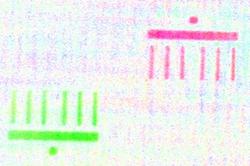URL: https://www.desy.de/information__services/press/press_releases/2012/pr_250112/index_eng.html
Breadcrumb Navigation
Guinness World Record: DESY's X-ray laser FLASH shoots fastest movie
Main part of the Brandenburg Gate hologram. Credit: Stefan Eisebitt/HZB. (HighRes).
Hamburg, 25 January 2012. It's official: The world's fastest movie was shot by DESY's X-ray laser FLASH in Hamburg. In its 2012 edition, the famous Guinness Book of World Records lists an interval of a mere 50 femtoseconds between two frames for FLASH. A femtosecond is a quadrillionth of a second, meaning that the two images are separated by just 0.000 000 000 000 05 seconds – this is 800 billion times faster than a feature film. On Thursday, Professor Stefan Eisebitt from Technische Universität Berlin and the Helmholtz Zentrum Berlin will present the record slow motion at the DESY light sources users’ meeting. As the film motif for the demonstration of the technique his group chose a micro model of the Brandenburg Gate, spanning only a few micrometres (millionths of a metre).
The specialised light sources at DESY offer scientists unique insights into the world of atoms and molecules and attracted more than 2500 guest users in 2011 alone. More than 600 participants registered for the three-day users’ meeting organised jointly by DESY and the European XFEL.
“The novel X-ray lasers will offer high speed films of ultrafast molecular processes and chemical reactions for a better understanding of these processes,” emphasises DESY's director of research Professor Edgar Weckert. At FLASH, Eisebitt and his team demonstrated the fastest imaging sequence so far. For this purpose, the scientists split the X-ray laser beam into two flashes and sent one of them via a detour of only 0.015 millimetres, making it arrive 50 femtoseconds later than the first one. Since no detector can be read out so fast, the scientists stored both images as superimposed holograms, allowing the subsequent reconstruction of the single images.
With these experiments, the scientists showed that this record slow motion is achievable. However, they did not only take the world’s fastest but probably also the shortest film – with just two images. Thus, additional development work is necessary for the use of this method in practice. “The long-term goal is to track the movements of molecules and nano structures in realtime,” Eisebitt said. His team also presented their work in the journal „Nature Photonics“ (DOI: 10.1038/NPHOTON.2010.287).
DESY/European XFEL Users‘ Meeting: https://indico.desy.de/conferenceDisplay.py?confId=5039
Press Contact
Dr. Thomas Zoufal, DESY press officer
+49 40 8998-1666, <presse@desy.de>
|
Optical lasers are used to synchronize free-electron lasers. Photo: Greg Hren/Research Laboratory of Electronics at MIT (HighRes). |
|





